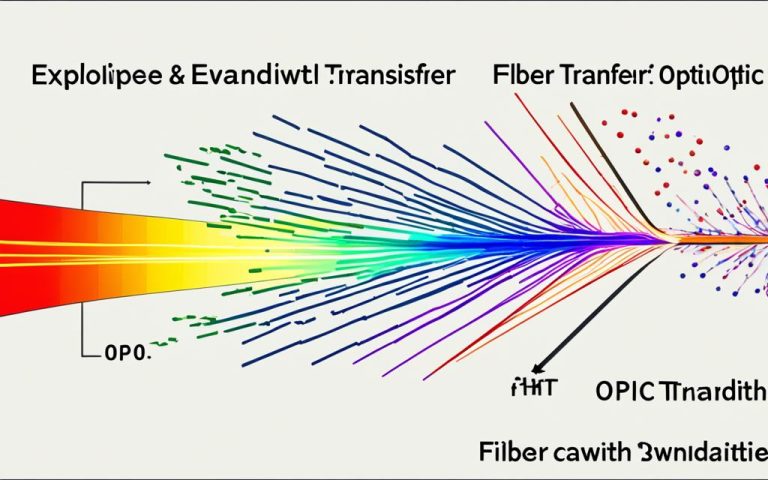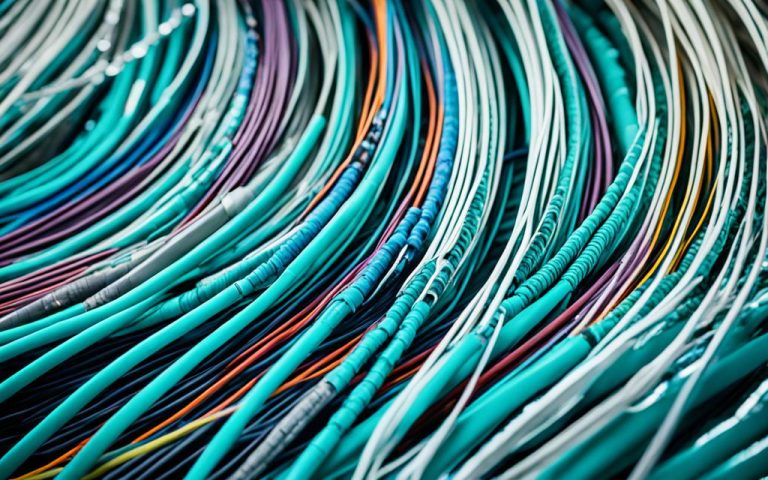If you’ve ever wondered how data travels through fiber optic networks or how different devices communicate seamlessly over digital infrastructures, the answer lies in networking protocols. These standardized rules and conventions play a vital role in ensuring efficient and reliable data transmission, routing, error handling, security, efficiency, and interoperability in fiber optic networks.
Understanding fiber optic protocols and networking protocols is essential for anyone involved in the world of information technology or anyone interested in modern communication. Whether you’re a network administrator, a tech enthusiast, or simply curious about the inner workings of digital infrastructures, this comprehensive guide will unravel the complexities of networking protocols in fiber optic networks.
In this guide, we’ll explore what networking protocols are, delve into the OSI model as a blueprint for networking protocols, discuss common protocols used in fiber optic networks, examine transport layer protocols, such as TCP and UDP, and analyze the advantages and disadvantages of fiber optics. By the end, you’ll have a solid understanding of how networking protocols power fiber optic networks and why they are crucial for modern communication.
So, let’s embark on this informative journey into the world of networking protocols and unravel the mysteries behind fiber optic networks and digital infrastructures.
What Are Networking Protocols?
Networking protocols are a set of rules and conventions that govern how data is transmitted, received, and processed in computer networks. They play a crucial role in ensuring effective and reliable communication between devices. These protocols provide standardized guidelines for various aspects of network communication, including data transmission, data routing, error handling, security, efficiency, and interoperability.
At its core, networking protocols define the format and structure of data packets, enabling devices to exchange information seamlessly. They establish the procedures for data transmission, specifying the order in which data is sent, how acknowledgments are received, and how errors are detected and corrected. By standardizing these processes, networking protocols ensure that data is delivered accurately and efficiently from the source to the destination.
Furthermore, networking protocols define the rules for data routing, determining the most optimal path for data to traverse along the network. This routing process involves making decisions at each network node, directing data packets to the appropriate destination. Efficient data routing minimizes latency and ensures that data reaches its intended recipient in a timely manner.
Error handling is another critical aspect of networking protocols. These protocols establish mechanisms to detect and recover from errors that may occur during data transmission. By implementing error detection and correction techniques, networking protocols ensure data integrity and prevent corruption or loss of information.
Security is an essential consideration in network communication, and networking protocols incorporate various security features to protect data from unauthorized access or manipulation. These security mechanisms may include encryption, authentication, and data integrity checks, safeguarding sensitive information from potential threats.
Efficiency is a key factor in network performance, and networking protocols are designed with optimization in mind. These protocols aim to minimize network congestion, reduce packet loss, and maximize throughput, ensuring efficient utilization of network resources and enhancing overall performance.
Lastly, interoperability is crucial for networks that encompass different devices and operating systems. Networking protocols establish a common set of rules and standards that enable seamless communication between diverse devices, allowing them to exchange data without compatibility issues.
In summary, networking protocols are the backbone of computer networks, providing the foundation for effective and reliable communication. By standardizing data transmission, defining routing paths, handling errors, providing security features, optimizing network performance, and enabling interoperability, these protocols ensure seamless connectivity and efficient data exchange in modern digital infrastructures.
The OSI Model: A Blueprint for Networking Protocols
The OSI (Open Systems Interconnection) model serves as a crucial framework for understanding the complexities of network communication. It divides the communication process into seven distinct layers, each responsible for specific tasks. Networking protocols operate at different layers of the OSI model, ensuring efficient and reliable data transmission throughout the network.
The seven layers of the OSI model are as follows:
- Physical Layer: This layer deals with the actual physical connection between devices, focusing on electrical and mechanical specifications. It defines the characteristics of cables, connectors, and network interfaces.
- Data Link Layer: The data link layer establishes reliable connections between directly connected nodes. It is responsible for framing data into frames, detecting and correcting errors, and controlling flow.
- Network Layer: The network layer manages the addressing and routing of data packets across different networks. It forwards packets based on IP addresses, enabling communication between different networks.
- Transport Layer: This layer ensures the reliable and orderly delivery of data between end-to-end communication partners. It handles segmentation, reassembly, flow control, and error recovery.
- Session Layer: The session layer establishes and maintains communication sessions between applications on different devices. It manages session setup, coordination, and termination.
- Presentation Layer: The presentation layer translates data into a format that the application layer can understand. It deals with data encryption, compression, and formatting.
- Application Layer: The application layer is where user applications and protocols interact directly. It provides services for tasks such as file transfer, email communication, and web browsing.
The OSI model’s layered approach allows for modular and standardized development of networking protocols. Each layer has its specific functions, ensuring a hierarchical and organized communication process. Networking protocols operating at different layers collaborate to provide efficient and reliable data transmission across networks.
Common Networking Protocols
In fiber optic networks, several common networking protocols are utilized to facilitate seamless data transmission, secure communication, and efficient resource access. Understanding these protocols is essential for optimizing network performance and ensuring reliable connectivity.
TCP/IP Protocol Suite: The Foundation of the Internet
The TCP/IP protocol suite serves as the backbone of the internet, enabling devices to connect, exchange data, and access online resources. This suite encompasses multiple protocols that operate at different layers of the OSI model, such as:
- TCP (Transmission Control Protocol): Provides reliable, connection-oriented data transmission, ensuring data integrity and error correction during network communication.
- IP (Internet Protocol): Facilitates the routing and addressing of data packets across networks, ensuring proper delivery to the intended destination.
HTTP/HTTPS Protocols: Enabling Secure Web Browsing
The HTTP (Hypertext Transfer Protocol) and HTTPS (HTTP Secure) protocols are primarily used for web browsing. They define how web browsers and servers communicate and exchange information. HTTPS, which uses SSL/TLS encryption, ensures secure data transmission, protecting user information and preventing unauthorized access.
DNS: Translating Domain Names to IP Addresses
The Domain Name System (DNS) plays a crucial role in converting domain names (e.g., www.example.com) into their corresponding IP addresses. This translation allows users to access websites and online services using human-friendly domain names rather than complex numerical IP addresses.
SMTP/POP3/IMAP Protocols: Facilitating Email Communication
Email communication relies on several protocols, including:
- SMTP (Simple Mail Transfer Protocol): Enables the sending and routing of email messages between servers.
- POP3 (Post Office Protocol version 3): Retrieves incoming email messages from a server to a client device.
- IMAP (Internet Message Access Protocol): Provides advanced email management features, allowing users to access and manage email messages on a remote server.
FTP: Efficient File Transfer
The File Transfer Protocol (FTP) is widely used for transferring files between systems and servers. It provides a reliable method for uploading, downloading, and managing files, making it essential for various applications and industries.
Understanding and leveraging these common networking protocols enables administrators to optimize network performance, enhance security, and ensure smooth communication in fiber optic networks.
Transport Layer Protocols: TCP and UDP
The transport layer protocols TCP (Transmission Control Protocol) and UDP (User Datagram Protocol) play a crucial role in data transmission. TCP ensures reliable, connection-oriented data transmission, making it suitable for applications where data integrity is essential. UDP, on the other hand, is connectionless and faster, making it suitable for applications that prioritize speed over reliability.
Transport Control Protocol (TCP)
TCP is a reliable transport layer protocol that guarantees the delivery of data packets in the correct order and without loss. It establishes a connection between two devices before transmitting data, ensuring that all packets are received and processed correctly.
TCP achieves reliable transmission by implementing various mechanisms, such as acknowledgment of received packets, retransmission of lost packets, and flow control to prevent data congestion. These features make TCP ideal for applications that require error-free and ordered delivery of data, such as file transfers, email communication, and web browsing.
However, the reliability of TCP comes at the cost of increased overhead, as it requires additional control information for error detection and recovery. This overhead can affect the overall speed of data transmission.
User Datagram Protocol (UDP)
UDP is a connectionless transport layer protocol that prioritizes speed over reliability. It does not establish a connection before transmitting data, resulting in a faster transmission process. UDP is commonly used in real-time communication applications, multimedia streaming, online gaming, and situations where minor data loss is acceptable.
Unlike TCP, UDP does not guarantee the order or delivery of data packets. It does not implement mechanisms for acknowledgment, retransmission, or flow control. Therefore, UDP has a lower overhead compared to TCP, providing faster data transmission.
The simplified nature of UDP makes it an excellent choice for applications that prioritize speed and responsiveness, such as video conferences, real-time audio streaming, and online gaming. However, due to its unreliable nature, UDP may suffer from packet loss, which can result in missing or out-of-order data.
| Transport Layer Protocol | Reliability | Speed |
|---|---|---|
| TCP | Reliable | Slower |
| UDP | Unreliable | Faster |

“TCP and UDP are two fundamental transport layer protocols that cater to different needs in data transmission. TCP provides reliability and ensures data integrity, making it suitable for applications that require accurate data transmission. On the other hand, UDP prioritizes speed and is ideal for applications where minor data loss is acceptable. Understanding the strengths and weaknesses of these protocols is essential for optimizing network performance and delivering the desired user experience.”
Advantages and Disadvantages of Fiber Optics
Fiber optics offer several advantages over traditional metal cables, making them a popular choice in modern communication networks. The following are some key advantages of fiber optics:
- Lower Cost: Fiber optic cables are more cost-effective in the long run compared to traditional metal cables. They require less maintenance and have a longer lifespan, reducing the need for frequent replacements.
- Better Signal Integrity: Fiber optics provide superior signal integrity over long distances. They are less susceptible to signal degradation and interference, ensuring reliable transmission with minimal data loss.
- EMI Immunity: Fiber optic cables are immune to electromagnetic interference (EMI) from nearby power lines or other electronic devices. This immunity leads to improved data transmission quality and reduces the risk of signal disruption.
- Safety: In hazardous conditions, fiber optics offer a safer alternative compared to metal cables. They do not conduct electricity, eliminating the risk of electrical hazards and providing added protection in high-voltage environments.
- High Bandwidth: Fiber optic cables have a significantly higher bandwidth compared to traditional cables. They can transmit large amounts of data at faster speeds, enabling high-speed internet connections and supporting bandwidth-intensive applications.
- Data Security: Fiber optics provide enhanced data security due to their design. They are difficult to tap into without detection, making them less vulnerable to unauthorized access or data breaches.
Despite their numerous advantages, fiber optics also have some disadvantages to consider:
- Complexity and Cost of Splitting: Splitting fiber optic cables into multiple connections can be complex and expensive. Additional equipment and expertise are required for efficient splitting, increasing the overall cost of implementation.
- Inability to Carry Electrical Power: Unlike traditional metal cables, fiber optics cannot carry electrical power. This limitation requires separate power cables to be installed alongside fiber optic cables for devices that require electrical power.
- Higher Initial Investment: The initial setup and infrastructure required for fiber optic networks can be more expensive compared to traditional networks. The investment includes the installation of specialized equipment and the laying of fiber optic cables.
Comparison Table: Advantages and Disadvantages of Fiber Optics
| Advantages | Disadvantages |
|---|---|
| Lower cost in the long run | Complexity and cost of splitting |
| Better signal integrity over long distances | Inability to carry electrical power |
| EMI immunity | Higher initial investment |
| Safety in hazardous conditions | |
| High bandwidth for high-speed data transmission | |
| Enhanced data security |
Considering both the advantages and disadvantages, it is important to carefully evaluate the specific requirements and constraints of each situation when deciding to implement fiber optic infrastructure. While fiber optics offer numerous benefits, it is essential to consider the potential complexities and costs involved in their deployment.
Conclusion
Fiber optic networks are dependent on networking protocols to guarantee efficient and dependable communication. A comprehensive understanding of the various networking protocols, the OSI model, and the advantages and disadvantages of fiber optic technology is essential for network administrators and enthusiasts alike. By implementing the appropriate protocols and infrastructure, fiber optic networks have the potential to offer high-speed, secure, and reliable data transmission in diverse digital infrastructures.
FAQ
What are networking protocols?
Networking protocols are a set of rules and conventions that govern how data is transmitted, received, and processed in computer networks. They ensure effective and reliable communication between devices by standardizing data transmission, defining data routing paths, handling errors, providing security features, optimizing network performance, and enabling interoperability between different devices and operating systems.
What is the OSI model?
The OSI (Open Systems Interconnection) model is a conceptual framework that breaks down the network communication process into seven layers. Each layer has specific responsibilities in the communication process, and networking protocols operate at different layers to ensure efficient and reliable data transmission. The layers include the Physical Layer, Data Link Layer, Network Layer, Transport Layer, Session Layer, Presentation Layer, and Application Layer.
What are some common networking protocols used in fiber optic networks?
Some common networking protocols used in fiber optic networks include the TCP/IP protocol suite, HTTP/HTTPS protocols for web browsing, DNS for translating domain names into IP addresses, SMTP/POP3/IMAP protocols for email communication, and FTP for file transfer.
What are the transport layer protocols TCP and UDP?
TCP (Transmission Control Protocol) and UDP (User Datagram Protocol) are transport layer protocols that play a crucial role in data transmission. TCP ensures reliable, connection-oriented data transmission, making it suitable for applications where data integrity is essential. UDP, on the other hand, is connectionless and faster, making it suitable for applications that prioritize speed over reliability.
What are the advantages and disadvantages of fiber optics?
Fiber optics offer advantages such as lower cost in the long run, better signal integrity over long distances, immunity to electromagnetic interference (EMI), safety in hazardous conditions, lightweight design, enhanced data security, high bandwidth for high-speed data transmission, and efficient digital data transfer. However, there are also disadvantages to consider, such as the complexity and cost of splitting fiber optics, the inability to carry electrical power, and the higher initial investment required for fiber optic infrastructure.
Why are networking protocols important in fiber optic networks?
Networking protocols are essential for ensuring efficient and reliable communication in fiber optic networks. By implementing the right protocols and infrastructure, fiber optic networks can provide high-speed, secure, and reliable data transmission in various digital infrastructures.




















4 Comments